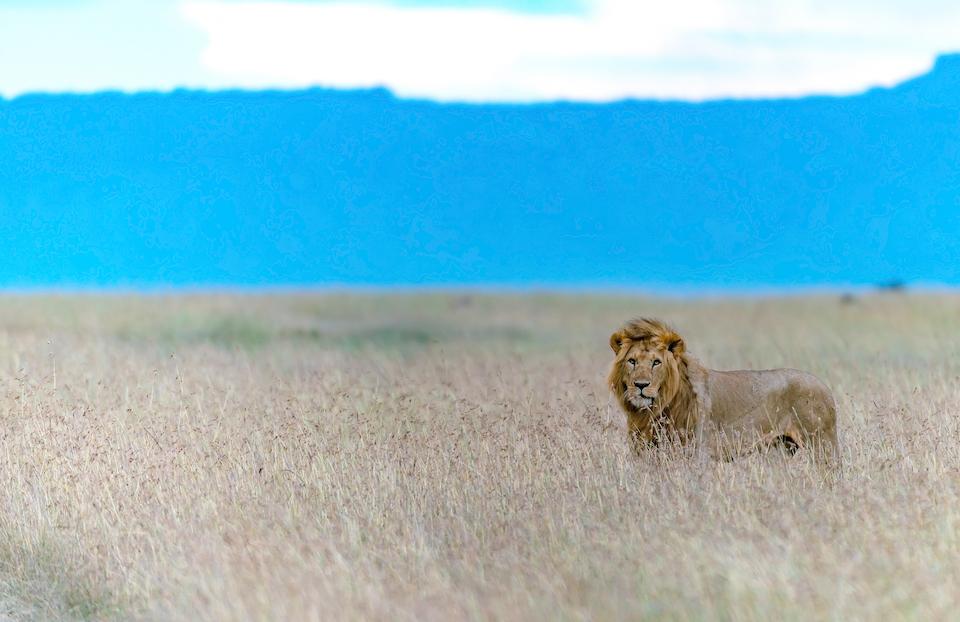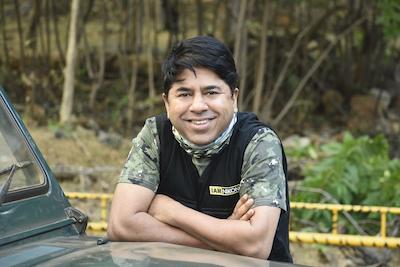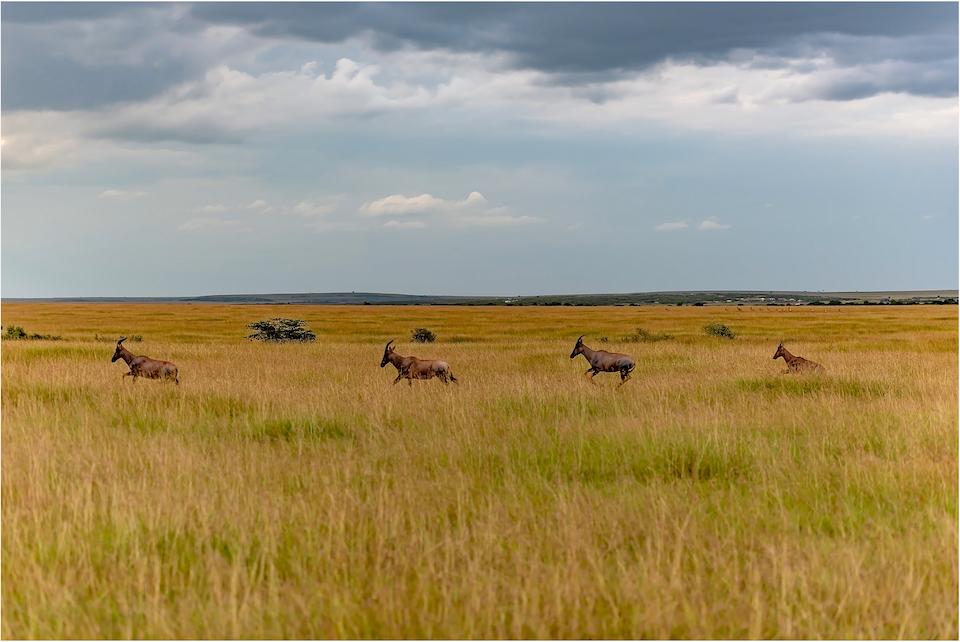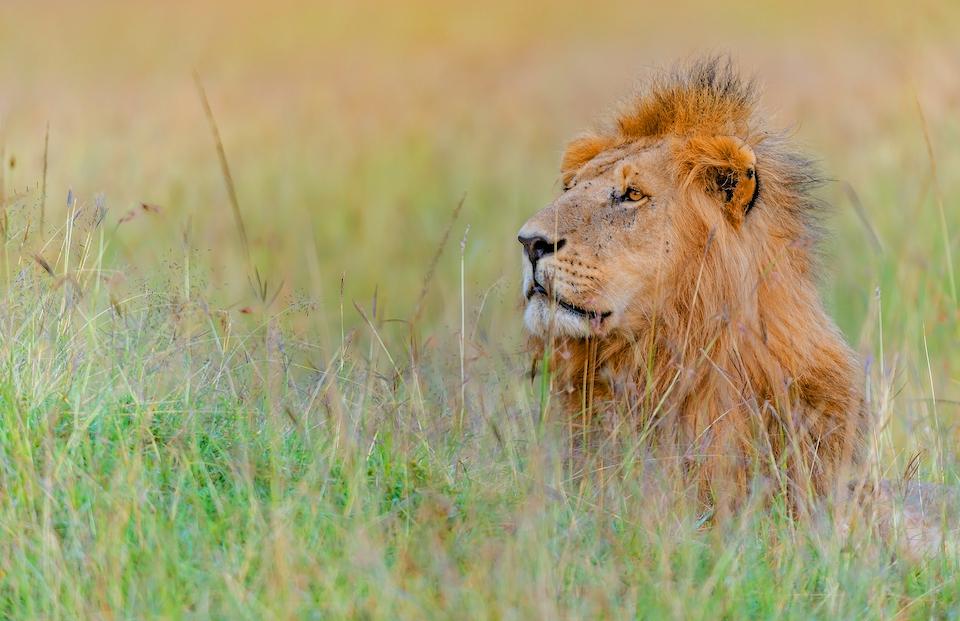
African lion/Debashish Dutta
Africa was always a dream. It still is the biggest attraction in my life. I often tell my wife that I will always give Las Vegas a pass if the other option is Africa.
Growing up in India was magical. The only piece of land on Earth that was blessed with all four big cats – tiger, lion, leopard, and cheetah. Unfortunately, we lost the cheetah in the 1850s due to indiscriminate hunting by the Maharajahs and their colonial cousins. There was a time when the delicious roar of the magnificent Royal Bengal Tiger came almost from the neighborhood, and the imprints of its visit on the garden soil very visible the next morning. So tells my Dad, who grew up in the thickly forested Indian state of Assam.

Debashish Dutta is an Indian professional natural history photographer recognized for his work by BBC Earth and Nikon Asia.
While growing up, nerve-racking, spine-tingling, heart-pumping stories of hunting man-eating tigers and leopards in India by such legends as Jim Corbett and Kenneth Anderson ensured that my passion for the wild and the wilderness was set on a never-ending, all-consuming fire, while stories by forest guides and jungle guards about their encounters with tigers, leopards, elephants, sloth bears, wolves, jackals, and hyenas went a long way in painting a magical and mysterious picture of the jungle in my heart and mind.
In August 2007, I made my way into the Jim Corbett National Park armed with a fine but borrowed point-and-shoot camera. Since then I have progressed to be a professional natural history photographer with access to a fine array of Nikon equipment.
Africa was always on my mind, but affordability was a big question mark too. While the wait for Africa was on, I followed the footprints of the magnificent Royal Bengal Tiger, the majestic leopard and the awesome Asiatic elephant across the length and width of India’s magnificent jungles.

On the Mara grasslands, a large game reserve in
Kenya, this herd of Topi was observed running for miles - quiet
curiously - in a single file/Debashish Dutta
On the tele, I was following the other big one – the lordly lion. Oddly, though, I so far have not pursued the Asiatic lion, which has been relegated to its only habitat in the state of Gujarat in India.
The African lion with its flowing mane – worthy of poetry – was out of my reach for many years.
The Internet with its ocean of information on myriad tour operators asking for tens of thousands of dollars while staking claims of being the best in class did not make my pursuit of Africa easier. I realized there were too many parties out there who made a living by taking people for a ‘ride’ to Africa. Fortunately, I had the patience and perseverance to perform in-depth research on how to make African safaris possible for wildlife lovers like me while keeping the budget in check and delivering a superior experience at the same time.
I completed my first and fabulous trip to Masai Mara in 2018 – at just about USD $2,500 all-inclusive for a six nights trip. We had a customized and brand new 10-seater Land Cruiser for the four of us, stayed at the very loving and warm Mara Olapa Camp, and had awesome food throughout!
March will find me in Tanzania, a trip that I have designed end-to-end with the knowledge and experience that I have gathered over the years. So intense has been our groundwork that Africa does not seem distant anymore.
Both Africa and India are replete with great national parks. Particularly for Africa, I strongly recommend the following. In fact, these parks are on my schedule till 2025.
- Ndutu, Tanzania: Go to Ndutu to witness the beginning of the legendary Great Migration. Rainfall arrives around early November in the Serengeti. Shortly, herds of wildebeest start arriving, accompanied by zebra and some other herbivores. At that time, they base themselves around southern and eastern Seronera, around Ndutu and in the northern Ngorongoro Conservation Area. What you see is an ocean of wildebeest, zebra, and other herbivores stuffing themselves on luxuriant grasses. January, February and March are the peak period for this marching contingent with the calving season in full swing and the subsequent arrival of wily predators; February and March are ideal to witness this spectacular natural phenomenon. Come March and the northward trot heralds the beginning of the Great Migration.
- Serengeti National Park, Tanzania / Masai Mara National Reserve, Kenya: No introduction required. For Africa’s Big Five (lion, leopard, rhinoceros, elephant, and Cape buffalo) and for immersion into nature’s canvas called the Savannahs, travel to these two parks is a must. From Tanzania; the Great Migration heads to Kenya via the Mara and the Grumeti rivers.
- Chobe National Park and Okavango Delta, Botswana: No words can do justice to the beauty of nature on display in these gardens of Eden. Come to Okavango, get into a Mokoro and get close to Africa’s iconic elephants as they splash and play in the waters of the delta providing terrific opportunities for photography. It is a sight to behold! Chobe is home to the largest population of the African elephant and is amongst the most biodiverse parks in the world. For birders, there might not be any other parallel on Earth so varied is the birdlife found in this incredible park.
- Kgalagadi Transfrontier Park, Botswana & South Africa: This is a tough park to be in, but an absolute gem simply because of the way nature has woven its tapestry here. This park is essentially a desert, but it’s a unique one. The tough conditions ensure few visitors who are dedicated wildlife lovers. The park is a story of vast arid landscapes with red dunes, sparse vegetation, and camel thorn trees. Animals congregate in the dry riverbeds and waterholes. Come to Kgalagadi for awesome huge black-maned lions who stalk herds of gemsbok, springbok, eland, and Blue wildebeest. The park presents sensational views of cheetahs on hunting missions. If you love wildlife, make the effort and visit from March to May.

Lion profile/Debashish Dutta
- Design your own trip.
- In general, avoid jungle tour operators – they have 100 percent or more markup.
- There is merit in building contacts on the ground. It is a painstaking exercise but well worth the effort. Facebook and Instagram are wonderful places to hunt for such contacts. Look for passionate wildlife lovers who travel frequently to Africa. Engage with them, for they will know all the right combinations and configurations.
- Especially in Kenya and Tanzania, make friends with the Masai. They are wonderful people who will create a very efficient and cost-effective Africa program for you while ensuring high levels of service and hospitality. They have expert knowledge of animal movement and provide vehicles that are configured with the photographer’s needs in mind. They double as driver and guide. Plus, they are a whale of fun.
- As a passionate wildlife lover, I don’t go to Africa with the mindset of staying at the Ritz Carlton. I prefer comfortable camps with good facilities that give me the feeling of being right in the lap of raw African wilderness. This also provides a more economical journey. And these guys know what crazy photographers want.
- Avoid suitcases on these kinds of trips. You are going to a jungle and all you need are comfortable shorts, cargo pants, a pair of jeans, tees, and comfortable shoes. All you need is a nice duffel bag. Travel light and easy.
- Your expensive DSLRs and lenses must be carried in a proper bag that can fit the overhead bin of a standard Airbus or Boeing airliner. Thinktank and Lowepro offer great options.
- Never check in your photographic gear unless you are carrying them in those large bulky hard cases. Be ready then to pay for excess luggage. And remember, if you have booked yourself into small aircraft that fly in and out of many African parks, such hard cases will be refused because they take up too much space.
- My preferred gear for photo safari consists of:
- Nikon D850: The most powerful and the coolest full frame out there, in my view. With back-button focusing and custom menus, this magnificent DSLR makes wildlife photography a breeze.
- Nikkor 14-24/F2.8/FL: For Africa’s incredible landscapes, you cannot do without this ultra-wide-angle lens. Fast, sharp, and incredible performance makes this lens a joy to work with.
- Nikkor 70-200/F2.8/FL: For quick action at close quarters, arm yourself with this killer lens that succeeds every single time. Flawless reproduction and sharp images are the hallmarks of this lens.
- Nikkor 200-400/F4: A lens that is a timeless classic. I have it in my bag for it gives me the flexibility I need. Remember; you need great light conditions for this lens to do its best.
- Nikkor 400/F2.8/FL: This one just cannot go wrong! Can it? If the length is right, this one nails the shot effortlessly.
- Great gear will deliver great results for competent photographers. Therefore, familiarity with both the art and science of digital photography is a must. I prefer my lenses to be tagged with a body each to avoid any kind of juggling when I am in action. This is also an efficient and safer way to handle sensitive and expensive equipment. However, do not have the lens and the DSLR paired while traveling. Any jerk or shock can jam the coupling pins and lead to equipment damage.
- I totally avoid tripods / monopods. They are bulky, add to your luggage, and are a pain in rough terrain. I trust bean bags and pillows for propping up cameras. They can be picked up and positioned anywhere in a flash, and afford very steady shots.
- Nothing protects your photo equipment from rain better than high quality industrial grade PVC packets. I always carry a bunch with me. Right at the first hint of rain, I quickly pack the stuff into these packets, close them with tough rubber bands, and push the packets quickly beneath a seat.
- To protect your equipment from fine dust, always cover them up with soft white cotton fabric. In India, you get something called the “Dupatta” – a kind of stole worn by women. I have a bunch of them with me on safaris to cover up my equipment nicely.
- You can also use the Dupatta to wrap your face and neck when the
sunlight becomes harsh. This is a great way to protect your face from
sunburns. Carry a water sprayer like the ones they use in salons to keep
your face cool and hydrated.
Debashish Dutta is an Indian professional natural history photographer recognized for his work by BBC Earth and Nikon Asia. His extensive wildlife photography portfolios can be found at www.fromdawntodusk.in He is also a senior banker with over 20 years of core corporate experience.
https://www.nationalparkstraveler.org/2019/12/african-photo-safari-simplified
No comments:
Post a Comment